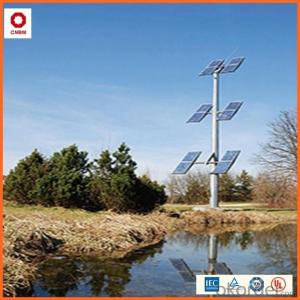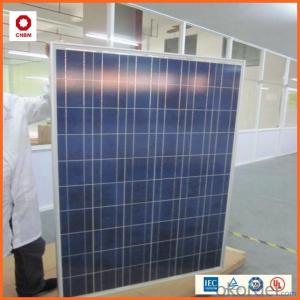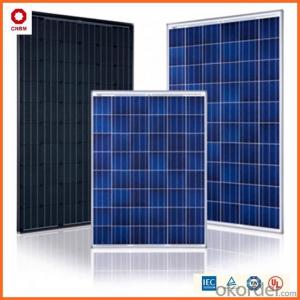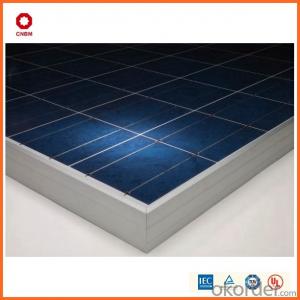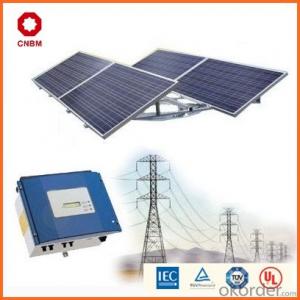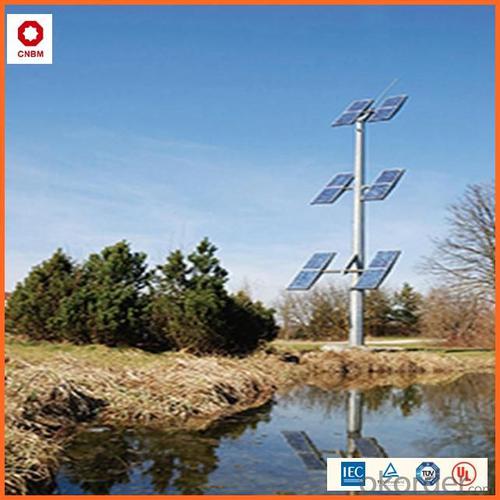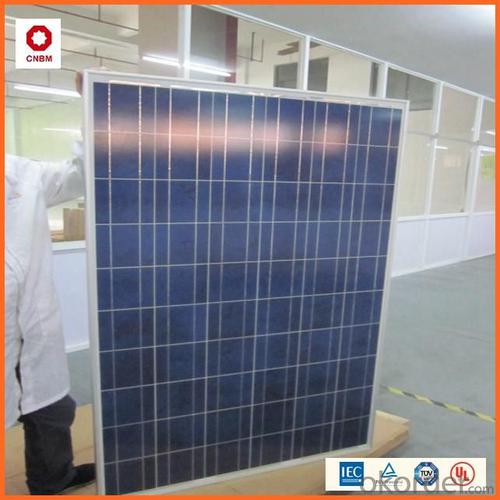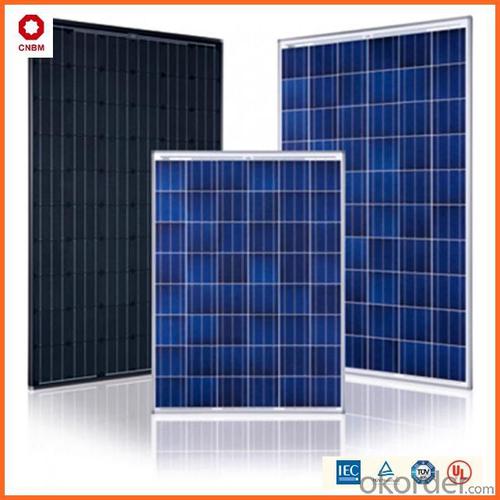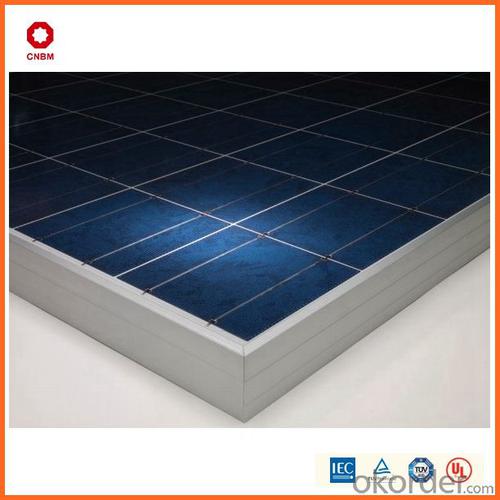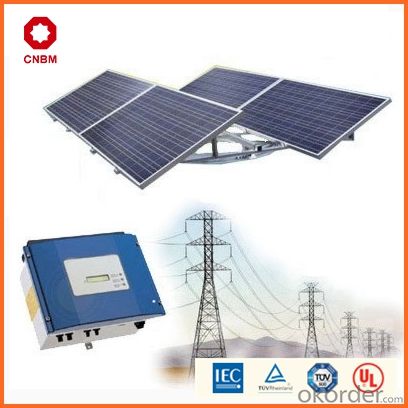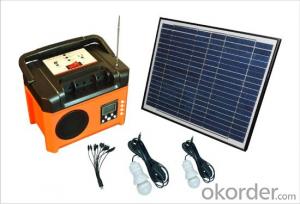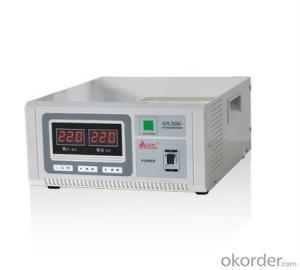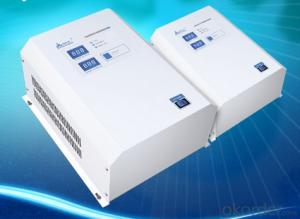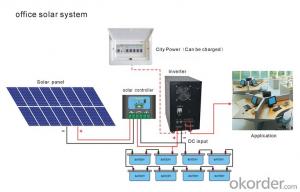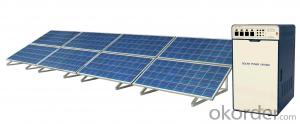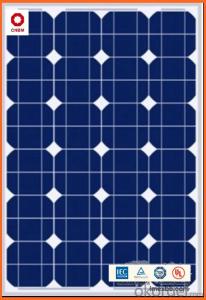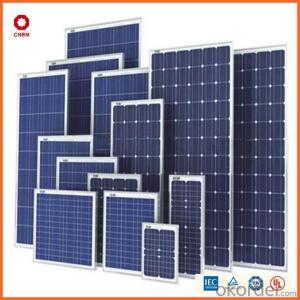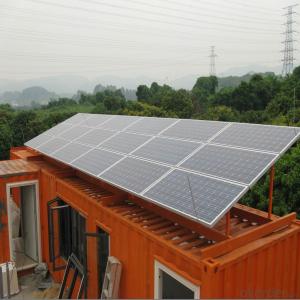Solar Energy Systems Brevard - 40w Small Solar Panels with Good Quality
- Loading Port:
- China main port
- Payment Terms:
- TT OR LC
- Min Order Qty:
- 1 watt
- Supply Capability:
- 10000000 watt/month
OKorder Service Pledge
OKorder Financial Service
You Might Also Like
Specification
Hot Sale !!! Quality and Safety of Small Poly Solar Panel 25~85w
1. Rigorous quality control meets the highest international standards.
2. High-transmissivity low-iron tempered glass, strong aluminium frame.
3. Using UV-resistant silicon.
4. IS09001/14001/CE/TUV/UL
Warranties of Small Poly Solar Panel 25~85w
1. 10 years limited product warranty
2. 15 years at 90% of the minimal rated power output
3. 25 years at 80% of the minimal rated power output
Specification
Characteristics of Poly solar panels CNBM (25-85W) | |||||
Max Power Voltage Vmp(V) | 30.3 | 30.8 | 31.1 | 31.4 | 31.85 |
Max Power Current Imp(A) | 7.60 | 7.64 | 7.73 | 7.81 | 7.85 |
Open Circuit Voltage Voc(V) | 36.1 | 36.6 | 37 | 37.3 | 37.68 |
Short Circuit Current Isc(A) | 8.50 | 8.55 | 8.65 | 8.75 | 8.85 |
Max Power Pm(W) | 230W | 235W | 240W | 245W | 250W |
Temperature Coefficient of Cells Poly solar panels CNBM (25-85W) | |
NOCT | 45± 2 |
Temperature Coeffucients of Isc | 0.0492 |
Temperature Coeffucients of Voc | -0.3374 |
Temperature Coeffucients of Voc | -0.4677 |
Mechanical Data of Poly solar panels CNBM (25-85W) | |
Dimension | 1638 × 982 × 40 mm |
Weight | 19.5 kg |
No. of Cells and Connections | 60 (6 ×10) |
Tolerance | 0 ~ + 5 W |
Cell | Monocrystalline Cell 156 × 156 mm |
Packing | 624 Pcs/40ft(H) Container |
Limits of Poly solar panels CNBM (25-85W) | |
Operating Temperature | -40 to +85 |
Storage Temperature | -40 to +85 |
Max System Voltage | 1000VDC(IEC) / 600VDC(UL) |
Features of our products:
• High conversion efficiency mono/poly-crystalline amorphous silicon solar cells
• Modules incorporate high performance bypass diodes to minimize the power drop caused by shading
• High transmittance, low-iron tempered glass
• High performance EVA encapsulant to prevent destroying and water.
• AI frame: without screw, corner connection. 8 holes on the frame can be installed easily
• Good performance of preventing from atrocious weather such as wind and hails
• Certifications: CE IEC TUV VDE UL, Class I
• 10 years 90% power output warranty
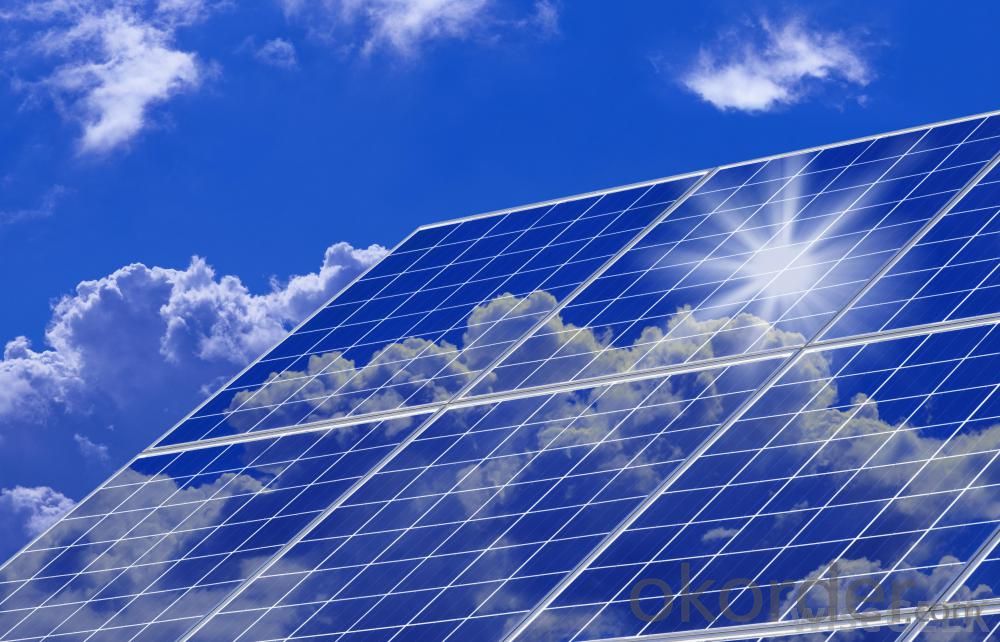
Shipping of Small Poly Solar Panel 25~85w
By Sea | Delivery from Shanghai or Ningbo seaport |
By Air | Departure from Shanghai Pudong Airport |
By Express | Post by DHL, EMS, UPS, TNT. |
- Q: How do solar energy systems impact utility bills?
- Solar energy systems can have a significant impact on utility bills by reducing or even eliminating the need for grid-supplied electricity. By generating clean and renewable energy from the sun, these systems can significantly lower electricity costs over time, as homeowners or businesses can rely on the power generated by their solar panels instead of purchasing electricity from the utility company. Additionally, excess solar energy can be fed back into the grid, allowing users to earn credits or receive compensation, further reducing their utility bills.
- Q: I want to put on the roof of the solar system from the building, 100 square meters, daily consumption of 6 to 8 degrees. Some users know how much to install KM? About the cost?
- Solar power generation, per square meter of power generation in 120W or so, the cost per square meter in 1500 yuan, the greater the area the lower the price
- Q: Can solar energy systems be used for air purification or water treatment?
- Yes, solar energy systems can be used for air purification or water treatment. The energy generated by solar panels can power various technologies such as air purifiers or water treatment systems, providing a sustainable and renewable solution for these purposes. Solar-powered air purifiers can help remove pollutants from the air, while solar-powered water treatment systems can sanitize and purify water for safe consumption.
- Q: Can solar energy systems be integrated with other renewable energy sources?
- Yes, solar energy systems can be integrated with other renewable energy sources. This integration can be achieved through hybrid systems that combine solar panels with technologies such as wind turbines, hydroelectric power, or geothermal energy. By combining multiple renewable energy sources, we can enhance overall energy generation and reliability while reducing dependence on fossil fuels.
- Q: Can solar energy systems be used for powering off-grid recreational vehicles?
- Yes, solar energy systems can indeed be used for powering off-grid recreational vehicles. Solar panels can be installed on the roof of the RV to capture sunlight and convert it into electricity. This renewable energy source can then be used to power various appliances, lights, and other electrical devices within the vehicle. It provides a reliable and environmentally friendly solution for RV owners seeking to go off-grid and reduce their dependence on traditional power sources.
- Q: How does a solar thermal system use sunlight to heat water or air?
- A solar thermal system uses sunlight to heat water or air by using solar collectors, typically consisting of flat panels or evacuated tubes, which absorb the sun's energy. The collectors are designed to maximize the absorption of sunlight and convert it into heat. Inside the collectors, there are pipes or tubes containing a heat transfer fluid, such as water or antifreeze, which is heated as it circulates through the collectors. This heated fluid is then used to transfer the heat to a storage tank where it can be used for hot water supply or circulated through a heat exchanger to warm air in a building. Overall, the solar thermal system harnesses the sun's energy to directly heat the water or air, providing a sustainable and renewable source of thermal energy.
- Q: Can solar energy systems be used in areas with limited access to sunlight due to tall nearby buildings or trees?
- Yes, solar energy systems can still be used in areas with limited access to sunlight due to tall nearby buildings or trees. While it is true that shading can decrease the efficiency of solar panels, there are several solutions to overcome this challenge. Firstly, solar panels can be strategically placed on rooftops or other elevated structures to minimize the impact of shading. By positioning the panels in areas where they receive the maximum amount of sunlight throughout the day, such as on the southern side of a building or in open spaces, the effects of shading can be minimized. Additionally, advancements in solar technology have led to the development of more efficient and flexible solar panels. Some panels are designed to work even in low-light conditions, allowing them to generate electricity even in areas with limited access to sunlight. Furthermore, the use of solar tracking systems can greatly enhance the performance of solar energy systems in shaded areas. These systems allow the solar panels to follow the movement of the sun throughout the day, ensuring that they are constantly exposed to the maximum amount of sunlight available. Finally, it is worth mentioning that a thorough site assessment and design by a professional can help identify the best options for solar energy systems in shaded areas. By carefully analyzing the site conditions and taking into account factors such as shading intensity, angle of incidence, and available space, a customized solar energy system can be designed to optimize energy generation even in areas with limited access to sunlight.
- Q: How do solar energy systems impact the electricity pricing structure?
- Solar energy systems can have a significant impact on the electricity pricing structure by reducing the overall demand for electricity from traditional sources. As more solar energy is integrated into the grid, it helps lower the peak demand and reduces the need for expensive peak power plants. This, in turn, can lead to lower electricity prices for consumers as the cost of generation and distribution is reduced. Additionally, solar energy systems often come with net metering programs, allowing homeowners or businesses to sell excess power back to the grid, further influencing the pricing structure by increasing the supply of electricity.
- Q: Can solar energy systems be used in areas with high levels of dust or sand?
- Yes, solar energy systems can still be used in areas with high levels of dust or sand. While the accumulation of dust or sand on solar panels can decrease their efficiency, regular cleaning and maintenance can mitigate this issue. Additionally, the design of solar panels has improved over the years to be more resistant to dust and sand, allowing them to continue generating power effectively even in such environments.
- Q: Can solar energy systems be used to power electric vehicles?
- Yes, solar energy systems can be used to power electric vehicles. Solar panels can be installed on the roof of a vehicle or in a stationary location to capture sunlight and convert it into electricity. This electricity can then be used to charge the batteries of electric vehicles, providing a clean and renewable source of energy for transportation.
Send your message to us
Solar Energy Systems Brevard - 40w Small Solar Panels with Good Quality
- Loading Port:
- China main port
- Payment Terms:
- TT OR LC
- Min Order Qty:
- 1 watt
- Supply Capability:
- 10000000 watt/month
OKorder Service Pledge
OKorder Financial Service
Similar products
Hot products
Hot Searches
Related keywords
